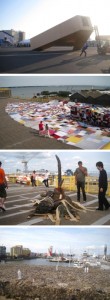Joint international project with the Ecole Regionale des Beaux-Arts de Nantes held in France
2014.03.24 | ALL
 The contemporary art exhibition project Estuaire Nantes < > Saint-Nazaire was held from June 5 through August 16 near the estuary of the Loire River, the body of water connecting the cities of Nantes and Saint-Nazaire in northwest France. As part of this project, the University and the Ecole Regionale des Beaux-Arts de Nantes held the Nantes CAS 8 international art-school exchange project (June 17 – July 9) in a terrace gallery on the rooftop of a waterfront fortress located in the city of Saint-Nazaire.
The contemporary art exhibition project Estuaire Nantes < > Saint-Nazaire was held from June 5 through August 16 near the estuary of the Loire River, the body of water connecting the cities of Nantes and Saint-Nazaire in northwest France. As part of this project, the University and the Ecole Regionale des Beaux-Arts de Nantes held the Nantes CAS 8 international art-school exchange project (June 17 – July 9) in a terrace gallery on the rooftop of a waterfront fortress located in the city of Saint-Nazaire.
This exchange project involved the creation of works on site, with students from each school visiting the other school’s nation. Four students selected from the University traveled to France in mid-May and spent roughly one month creating works of art there. These works were then exhibited alongside works by four students from the Ecole Regionale des Beaux-Arts de Nantes.
Plans call for the same participants to take part in preparing works of art in Japan for the “Ueno Town art Museum (UTM)” project taking place in Tokyo’s Taito Ward.
Prof. Ritsuko Taho of the Department of Intermedia Art, who supervised the exhibition in Nantes, made the following remarks.
“In the Estuary Project symposium entitled “Beyond the Monument,” we recognize anew the need for public projects for the future of cities and regions, including efforts to reconcile the mainstream of the public art tradition in which works of art create public spaces with new approaches and considerations for the natural environment, as significant changes occur in the traditional conceptualization of public art as monuments. This is achieved not just through the art itself but through the considerable efforts of all those who are involved in or otherwise contribute to the process. In the works produced on-site as part of this project, the students involved did their utmost to surpass their own limits, growing significantly in the process. To witness this was invigorating, and it fills me with hope for the future.”
Prof. Hoshina of the Department of Painting, who supervised the project, had the following comments.
“This exchange project was initiated at the prompting of the Ecole Regionale des Beaux-Arts de Nantes, following roughly one year of preparations. Most international exchanges in the past have mainly involved faculty members, but this project was revolutionary in two respects: students played the primary role, and they created their works on-site. This fall, the same eight participants will take part in the UTM project. I look forward to seeing how the students from the Ecole Regionale des Beaux-Arts de Nantes will express the world of traditions and the region’s power during the Edo Period, which persist in the Ueno area, alongside the modern world.”




